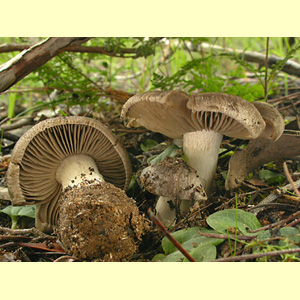
images/Porpoloma/Porpoloma4.jpg


_AL_24_sml.jpg)
Diagnostic characters
Medium to large agaric, growing on the ground, with a white spore print. Pileus brown or grey, not viscid. Lamellae sinuate or notched or subdecurrent. Stipe central. Partial veil remnants absent. Volva present or absent. Often bruising pink, yellow or brownish black. Spores hyaline, amyloid, smooth; germ pore absent. Cheilocystidia present or absent. Lamellar trama regular. Pileipellis a cutis or a trichoderm. Clamp connections present.
Similar genera
Very similar to Tricholoma in the general shape of the fruit body, and in the sinuate lamellae, differing in the amyloid spores and the presence of clamp connections. The presence of a volva in some species (especially in combination with smooth, amyloid spores) also suggests Amanita. However, the latter has a bilateral lamellar trama. the lamellae are never sinuate, and most have an annulus in combination with distinct squamules on the pileus surface. Larger species of Inocybe, which share the fibrillose and rimose pileus surface (and can have a volva), differ in the brown spore print and non-amyloid spores. Because the lamellae are sometimes thick, compare also larger species of Hygrocybe subgenus Cuphophyllus. However, these do not have sinuate lamellae, the pileus surface is not squamulose and the spores are non-amyloid.
Citation
Porpoloma Singer, Sydowia 6: 198 (1952).
Australian species
Several undescribed species, one close to the South American Porpoloma sejunctum and another resembling the New Zealand P. amyloideum.
Porpoloma penetrans belongs in Heimiomyces.
Australian distribution
W.A., Vic. and Tas. (and possibly also S.A., Qld and N.S.W.).
Habitat
In native forests, most commonly in cool-temperate rainforest with Nothofagus, but also in drier areas.
Substrate
On the ground.
Trophic status
Southern Hemisphere species are considered to be ectomycorrhizal (Singer, 1986).
References
Horak, E. (1980a), Fungi, Basidiomycetes. Agaricales y Gasteromycetes secotioides, Fl. Criptog. Tierra del Fuego 11(6): 1–524.[Description, Microcharacters and B&W Illustration of P. sejunctum from South America]
Stevenson, G. (1964), The Agaricales of New Zealand: V, Kew Bull. 19: 1–59 [Description, Microcharacters and Illustration of P. amyloideum from New Zealand (as Tricholoma amyloideum), plate is cited in text as 4/4 but should be 4/5].
